At Access Rehabilitation Equipment, we commit to providing you and your loved ones solutions for life! Fitting your lifestyle, each aid and equipment is tailored to the unique challenges you are facing, so work with us to find the independence and mobility you want!
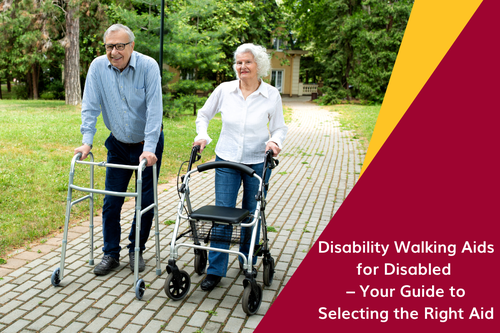
Disability walking aids are essential tools that provide support, stability, and independence for individuals with mobility challenges. However, choosing the right walking aid can be difficult because mobility issues vary widely, and it can be challenging to decide if you don’t know how each device works.
This article will explore various types of walking aids and discuss key factors that influence the selection process. From simple canes to more advanced rollators, understanding the available options will help you determine which aid best suits your needs.
Types of disability walking aids
Disability walking aids fall into multiple categories and include the following:
1. Walking Stick or Cane
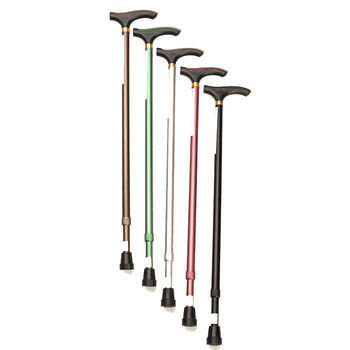
Walking sticks or canes are the most basic form of walking aid. They provide support and stability for those with minor balance issues. Canes come in two primary forms:
- Standard Cane: A single-point cane that offers light support.
- 3-4 Prong Sticks: These have multiple contact points with the ground for extra stability and support.
2. Walking Frame
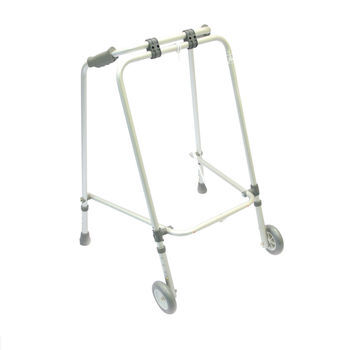
Walking frames, also known as walkers, offer more support than canes. They are lightweight and come in different varieties:
- Folding or Fixed Frame: Choose based on storage and portability needs.
- With or Without Rear Wheels: Wheels can make the walker easier to move but may be less stable for some users.
3. Forearm Walkers
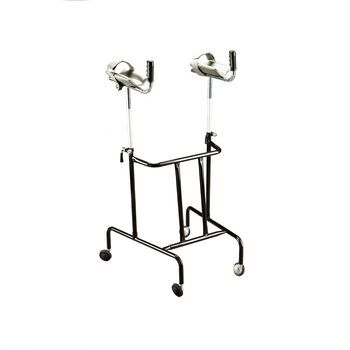
Forearm walkers, also known as gutter walkers, provide support for the forearms, distributing weight away from the hands and wrists. They are beneficial for individuals with limited hand strength or those recovering from surgery or injury.
4. Walking Frame with Seat
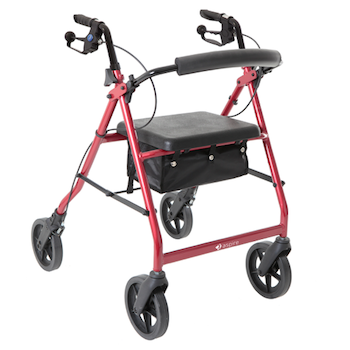
Also known as rollators or wheelie walkers, these walking frames have wheels, handbrakes, and a seat. They are ideal for both community use and home use, offering mobility support and a place to rest when needed.
How to select the right disability walking aid?
The right disability walking aid should enhance your ability to move comfortably while providing adequate support for your specific needs. When choosing a walking aid, consider the following factors:
- Personal Needs: Assess your requirements for balance support, hand strength and control, and the ability to lift the aid if necessary.
- Usage Environment: Determine where you'll primarily use the walking aid, whether it's indoors, outdoors, or while shopping.
- Future Needs: Consider potential changes in your mobility to avoid frequent replacements.
Walking aids for use around the home
When choosing a walking aid for use around the home, prioritise those that are easy to maneuover in tight spaces, lightweight, and offer essential support for daily activities. Here are walking aids designed specifically for home environments:
-
Rollator
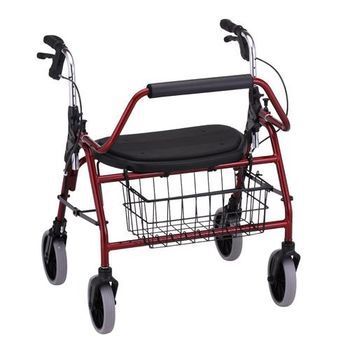
A versatile aid featuring wheels, handbrakes, a seat, and often a storage basket. Rollators provide support while walking and offer a place to rest, making them ideal for those who need frequent breaks or assistance carrying items.
-
Indoor walker
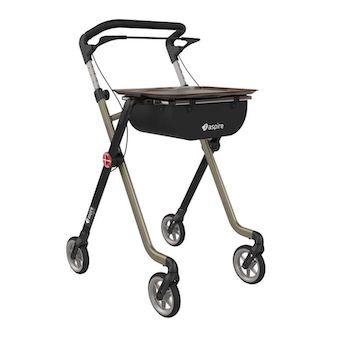
Indoor walkers are narrower and more maneuverable than outdoor models. They're lightweight, easy to lift over thresholds, and navigate tight spaces like hallways and bathrooms with ease.
-
Kitchen trolley
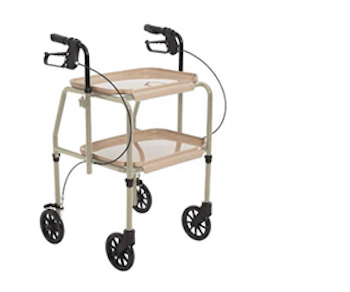
This specialised aid combines mobility support with functionality in the kitchen. Kitchen trolleys typically features multiple shelves or trays and wheels for users to safely transport items while moving around, thus maintaining independence in meal preparation and serving.
-
Space saver walker
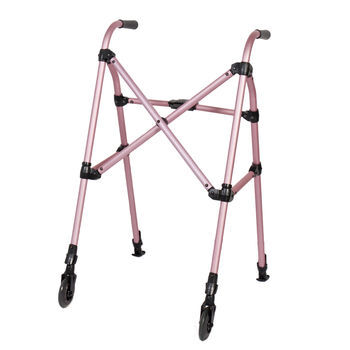
An incredibly lightweight option with rear skis for smooth indoor movement. Space saver walkers fold compactly, making them perfect for small living spaces or travel. While not suitable for outdoor use, they're excellent for those needing minimal support in confined areas.
Walking Aids for Stroke Recovery or Parkinson’s
Stroke survivors and individuals with Parkinson's disease often require specialised walking aids to address their unique mobility challenges. These conditions can affect balance, gait, and motor control, making standard mobility aids insufficient.
The following aids are designed to provide enhanced stability, support, and in some cases, technological assistance tailored to the specific needs of those recovering from stroke or managing Parkinson's symptoms:
-
U-Step walker
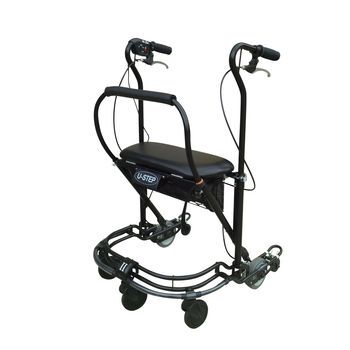
Designed specifically for individuals with neurological conditions, the U-Step walker offers enhanced stability and control. It features a unique reverse braking system that only moves when the user releases the brake, reducing the risk of falls. The enclosed frame provides multi-directional support, while the adjustable speed control allows for customised pacing, making it ideal for those with Parkinson's freezing episodes or stroke-related balance issues.
-
Forearm walkers
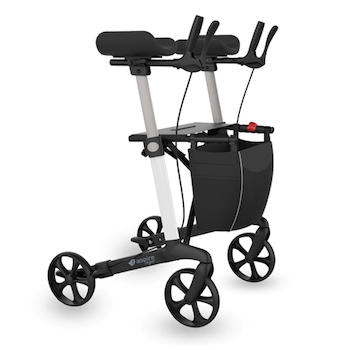
Forearm walkers provide support through the forearms rather than the hands, making them excellent for those with limited hand strength or grip issues common in stroke survivors. The ergonomic design helps maintain proper posture and reduces strain on the wrists and shoulders. Some models include features like swivel wheels for improved maneuverability and height adjustability for personalised comfort.
-
Laser cane
This high-tech walking aid projects a laser line on the floor that provides a visual cue to help overcome freezing of gait in Parkinson's patients. The laser line acts as a target for the user to step over, potentially reducing fall risk and improving walking confidence. It combines the simplicity of a traditional cane with advanced technology to address specific Parkinson's symptoms.
-
Quad cane
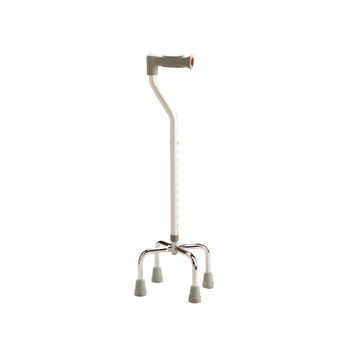
A more stable alternative to a standard walking stick, the quad cane has a four-pronged base that offers greater support and balance. It's particularly useful for stroke survivors who have weakness on one side of the body. The wider base provides more stability than a traditional cane while still being relatively lightweight and easy to maneuver.
-
Walking stick
As recovery progresses, a walking stick may suffice for many individuals. It provides light support and balance assistance, and can be easily carried and stored. For those with residual weakness or mild balance issues, a walking stick can offer the right amount of support while encouraging increased independence.
Funding for disability walking aids
Accessing financial support for walking aids is crucial for many individuals. Several funding options are available in Australia, varying based on age, location, and specific circumstances:
-
NDIS (National Disability Insurance Scheme): Supports Australians under 70 with permanent and significant disabilities. The NDIS can fund mobility aids as part of a participant's plan.
-
My Aged Care - Home Care Packages: Designed for those over 65 (or 50 for Aboriginal and Torres Strait Islander people). These packages can include funding for mobility equipment.
-
State-based programs:
- SWEP (State-wide Equipment Program) in Victoria
- ENABLE NSW in New South Wales
- MASS (Medical Aids Subsidy Scheme) in Queensland
- Similar programs exist in other states and territories.
- DVA (Department of Veterans' Affairs): Provides support for eligible veterans, war widows, and widowers.
-
TAC (Transport Accident Commission): Assists individuals injured in transport accidents in Victoria.
Application process:
Most government funding programs require an assessment and recommendation from a qualified healthcare professional, typically an occupational therapist or physiotherapist. This ensures the equipment meets your specific needs.
It's advisable to consult with a social worker or your healthcare provider to explore all available funding options in your area. They can guide you through the application process and help determine the most suitable funding source for your situation.
Conclusion
Selecting the right walking aid is crucial for your mobility and independence. If you're unsure, we invite you to visit our store where our team can offer personalised assistance and allow you to trial different aids before purchasing. Additionally, consider consulting an occupational therapist who can assess your needs, recommend suitable equipment, and guide you through the funding application process.
Taking these steps will help ensure you find the perfect walking aid to enhance your safety and quality of life. Remember, the right aid can make a significant difference in your daily activities, so don't hesitate to seek expert advice and take the time to find the best fit for you.
You may also like:


 Providing solutions for life
Providing solutions for life







